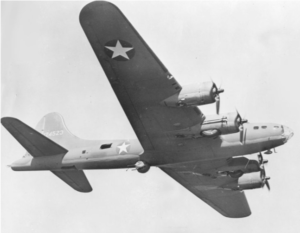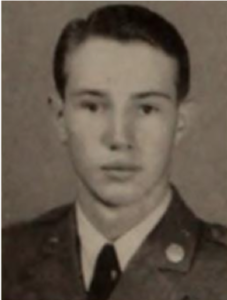Scroll of Honor – Robert Mixon
Ball Turret Gunner
It was the most isolated position on the crew. Sure, the tail gunner was stuck at the very back of the fuselage beneath the tail section, but at least he could crawl back through the narrow tunnel and into the B-17’s waist when things calmed down. Not so for the ball turret gunner.  Once he climbed into the cramped, hydraulically controlled turret in the belly of the airplane, the ball turret gunner was alone. Sure, he had a great view, able to spin his turret in any direction, but he was also exposed to enemy fire coming from any point on the compass.
Once he climbed into the cramped, hydraulically controlled turret in the belly of the airplane, the ball turret gunner was alone. Sure, he had a great view, able to spin his turret in any direction, but he was also exposed to enemy fire coming from any point on the compass.
After closing his hatch and being lowered into position, hanging beneath the airplane at frigid altitudes of up to 25,000 feet, the ball turret gunner’s only contact with the rest of the aircraft’s crew was through the interphone. There was no room to stretch out and relieve aching muscles, no “relief tube” for bodily functions, and should the Plexiglas bubble in which he sat be pierced by bullets or shrapnel, the gunner would have to battle frostbite as well as the enemy.
When Boeing designed the B-17, Army Air Corps planners envisioned a heavily-armed aircraft capable of its own defense against speedier, more maneuverable fighters. To that end, the Flying Fortress, as the B-17 came to be known, bristled with machine guns, from nose to tail, dorsal to belly.
It was into the ball turret on the underbelly of B-17 Gremlin’s Buggy that Staff Sergeant Robert Mixon, Jr. climbed on a cold November morning in 1943.
Robert Mixon had entered Clemson College the fall semester of 1940. There was trouble aplenty overseas, but the sentiment among most Americans was that the fight was Europe’s business, not ours. Mixon was from the growing town of Yemassee which straddled the Beaufort and Hampton County line with a population of 684, up more than twenty-five percent from the 1930 census. Hailing from a rural area, it seemed only natural that Mixon would study agriculture at Clemson.
Mixon remained at Clemson for two years, then joined the Army Air Forces. By that time, the war that had seemed so far away had reached out and ensnared the United States. The American military was mobilizing at an unprecedented pace and the first Americans into the fight against the Germans in Europe were the men of the Army Air Forces, particularly the heavy bombers of the Eighth Air Force.
Mixon was assigned to the 385th Bomb Group which arrived in England in June 1943 and established its headquarters at Great Ashfield,  Suffolk, on England’s east coast. The 385th earned a Distinguished Unit Citation for its participation in the long, hazardous Regensburg mission in August of that year.
Suffolk, on England’s east coast. The 385th earned a Distinguished Unit Citation for its participation in the long, hazardous Regensburg mission in August of that year.
On November 29, three hundred sixty B-17s, including Gremlin’s Buggy took off on the Eighth Air Force’s one-hundred-fortieth mission, its target the north German port of Bremen. Lieutenant Richard Yoder was the pilot and leader of the ten-man crew which included copilot Lieutenant Robert Payne, a bombardier, navigator, top turret gunner/flight engineer, radio operator, two waist gunners, the tail gunner and Mixon in the ball turret. It was Mixon’s twenty-second combat mission.
Payne recalled that he left the flight deck and “went back to the bomb bay for a few minutes as we passed over France and all seemed well and in good spirits.” The B-17s were scheduled to hit the target beginning at approximately 1430 hours, but unfavorable cloud conditions and the malfunction of radar bombing equipment caused more than two hundred of the aircraft to abort the mission. Not so for Gremlin’s Buggy. Yoder, Payne, Mixon and the crew pressed on through the perilous skies.
As the bomber formation approached the target, enemy anti-aircraft fire became more intense—and more accurate. Payne remembered that Mixon, from his unique vantage point beneath the airplane, could see flak explosions getting closer. Mixon reported, “They are bursting right beneath us!” “Then,” Payne said, “all went dead as we found we had gotten into a bit of trouble… it is very possible that the radio op(erator) and ball gunner had been killed.” The five men in the front part of the airplane were able to bail out and were taken prisoner by the Germans. Gremlin’s Buggy crashed near Fesenfeld, about fourteen miles south of Bremen. The radio operator and the four gunners in the aft section of the plane, including Mixon, were killed.
Over twelve thousand B-17s were built. Thirty-five hundred were shot down over Europe.  Each aircraft carried a crew of eight to ten men, many of whom, like Robert Mixon, Jr., never came home.
Each aircraft carried a crew of eight to ten men, many of whom, like Robert Mixon, Jr., never came home.
For more information about Staff Sergeant Robert Mixon, Jr. see:
https://soh.alumni.clemson.edu/scroll/robert-mixon-jr/
For additional information about Clemson University’s Scroll of Honor see:
